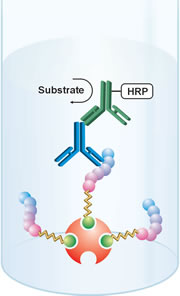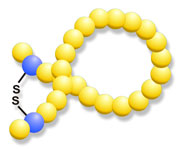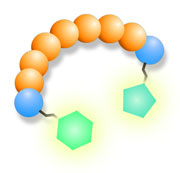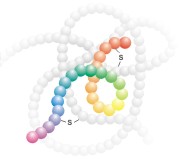Labels and Modifications
|
||||||
|
|
This page provides background on some of the more common peptide modifications that Mimotopes offers. Many of these can apply to PepSets Peptide Libraries as well as individual custom peptides.
Biotinylation
Addition of a biotin group to a peptide is a convenient way to detect or immobilize the peptide. The extremely high specificity and affinity of the biotin-avidin interaction is exploited. The peptide can be detected through the use of a chromophore-labeled or enzyme-labeled avidin or streptavidin. The peptide can also be immobilized onto plastic, or gel, which has been coated or coupled to avidin or streptavidin, enabling binding to the peptide to be measured, or enabling the peptide to be used as an adsorbent.
|
Biotin can be added to a peptide as an N-terminal capping group, or can be added to the sidechain of a lysine residue ("biocytin", for example, a lysine at the C-terminus of the peptide). An important consideration when making a biotinylated peptide is to ensure there is a sufficient spacer arm between the biotin group and the amino acids in the peptide which are expected to interact with a macromolecule (such as an antibody). Typically, a hydrophilic tetrapeptide such as -SGSG- or a hydrophobic straight chain hydrocarbon spacer can be added between the biotin and the sequence of interest, to prevent steric hindrance.
Phosphorylation
Protein phosphorylation is a key process in regulatory pathways. Phosphopeptides therefore have many uses in research, including their use as probes for studying intracellular processes and their use as antigens for raising specific antiphosphopeptide sera. Mimotopes make phosphopeptides from phosphoamino acids and therefore we can guarantee that the correct amino acid is phosphorylated. We have extensive experience with making and affinity-purifying antiphosphopeptide sera and can advise you on a strategy for maximizing the usefulness of any phosphopeptides you may order for making your own sera.
|
Cyclization
The structure of a peptide is determined by its sequence and the chemical environment in which it is placed. Linear peptides are relatively unrestrained and are able to adopt a range of conformations that are not always ideal for some applications. Cyclizing the peptide can restrain these conformations and increase the utility of the peptide in certain applications. One such method is to form a disulfide bridge between two Cysteine residues. Mimotopes routinely carries out this reaction and has considerable experience in the formation of these disulfide bridges.
Cyclic structures occur naturally in proteins and are also often the designed structure in phage random peptide library screening. We can cyclize your peptide if it contains two Cysteine residues. Other unusual thiol containing residues can also be used to cyclize your peptide. Peptides with two or more Cysteine residues can polymerize or cyclize in unwanted ways and it is likely the final product will contain a mixture of various polymers and cyclic peptide conformations. Typically the highest purity we offer for peptides ordered with a disulfide bond is >80%.
|
Fluorescent Labels
A way of detecting peptide is to add a fluorescent reporter group during synthesis. We offer the addition of a range of common fluorophores, either by addition to the N-terminus (capping the alpha-amino group), or by coupling onto the side chain of a lysine residue anywhere in the peptide. We can also make doubly-labeled fluorescent peptides, which are useful for direct measurement of peptide cleavage (by measuring changes in quenching).
Intracellular Targeting
An intracellular targeting peptide sequence can be synthesized integral with the unique sequence you are studying. While this often makes the overall peptide fairly long, we have found that the highly basic nature of the targeting sequences assists with peptide solubility and thus the success rate for such targeting peptides is good. We are happy to advise and quote on such sequences.
|
Peptide Conjugation
Covalent coupling of a peptide to a protein or gel is frequently needed so that the peptide can be used as an immunogen or for affinity purification. We offer conjugation of peptides to a variety of immunogenic carrier proteins, such as Diphtheria toxoid or Keyhole Limpet Hemocyanin, using one of several conjugation chemistries. One of the most specific and reliable conjugation chemistries uses a cysteine residue in the peptide and a maleimide group added to the carrier protein, to form a stable thioether bond 1. We also offer coupling of peptide to various types of gel to create an immunosorbent, for positive or negative selection of macromolecular binding entities, such as antibodies.
References
1. Lee, A.C., Powell, J.E., Tregear, G.W., Niall, H.D. and Stevens, V.C. (1980) A method for preparing b-hCG COOH peptide-carrier conjugates of predictable composition. Mol. Immunol. 17; 749-756.








